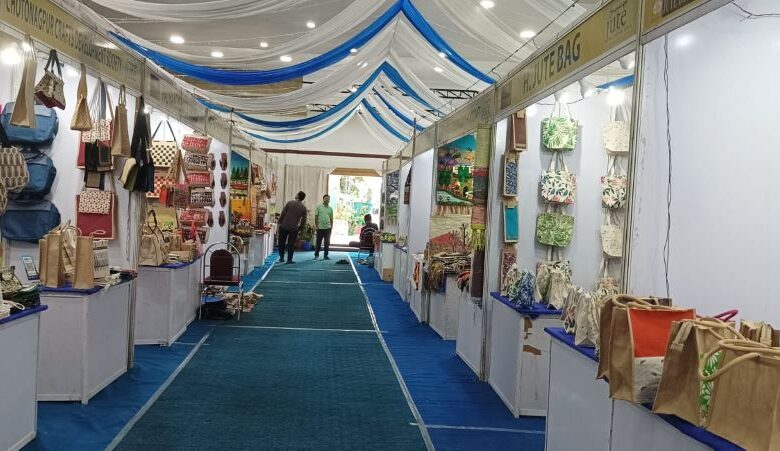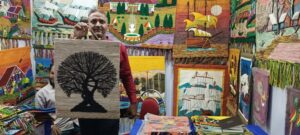NJB holds Jute Fair in city to promote eco-friendly fibre
But shop owners disappointed as lack of advertisement & media information has led to low footfall

Mahafuz Alam has come all the way from Ghazipur in Uttar Pradesh to Shillong to showcase the jute creations of local artisans. Alam’s Khwaja Handloom Awam Handicrafts specialises in wall hangings weaved in jute with a variety of motifs. This is his first visit to the northeastern state.
For Swapna Purkait too, this is the first visit to Shillong. Her creations include jute jewellery and home décor items and her store, Upahar, in Kolkata, has a strong customer base.
Both Alam and Purkait are among the 16-18 jute entrepreneurs who are participating in the Jute Fair at Shillong Club organised by the National Jute Board (NJB), under the Ministry of Textiles. This is the first such fair in the city after 2016.
At a time when plastic pollution is creating havoc worldwide, jute is being advocated as an alternative for an eco-friendly and sustainable fibre that can be equally versatile. NJB is doing its part to promote this golden fibre in the North East where bamboo has been the traditional favourite.
The jute entrepreneurs have come from West Bengal, Jharkhand, Uttar Pradesh and Nagaland. While those from West Bengal have an array of jute products — such as jewellery, tote and sling bags and shoes — those from Uttar Pradesh specialise in wall hangings. “In fact, Uttar Pradesh is the only state where these jute home decors are popular. They export these items too,” said Partha Bose, who is looking after marketing for NJB.
MK Ansari of Shaiqa International in Kolkata is an exporter of jute bags. “It is high time we say no to plastic bags as these are non-degradable and have a debilitating impact on the environment. We make jute bags and supply across the country as well as outside and the demand is quite high,” said Ansari, who has 40 workers in his factory in Rishra in Hooghly district.
Rakesh Mondal of Rakesh Handicrafts, who has come from Kolkata, said he makes miniature home décor items with jute which are popular among the younger generation. Mondal was also selling costars, dolls and other décor items made from jute byproducts. “I have held exhibitions in different parts of the country and most of them were organised by the government. I have also participated in private exhibitions,” he added.

NJB has introduced various schemes to support jute product makers and sellers and is helping entrepreneurs diversify to make the eco-friendly fibre marketable. NJB is also promoting jute geotextiles, which are applied in the soil to improve its engineering properties.
When asked how the board is popularising the fibre in the North East where bamboo products are more in vogue, Bose said NJB has a pro-rural scheme under which training programmes are conducted and artisans and self-help groups are being supported to market their products.
“For instance, in Nagaland, we encourage self-help groups to sell other traditional indigenous items alongside jute products. We provide them 25% subsidy on the GST incurred on the sales of jute products. This is one way of popularising the fibre here,” Bose explained.
NJB also runs a scheme, called Jute ICARE, under which cultivation and advanced retting exercises are encouraged. The project has resulted in increased production from 22-23 quintals per hectare to 26-28 quintals/hectare. It has also helped in increasing farmers’ income by about Rs 10,000 per hectare owing to the improvement in yield and quality.

Hiccups at Jute Fair
Despite the support from NJB, the sense of disappointment among the participating entrepreneurs was palpable. Even on a weekend, the footfall at the fair was abysmal and many stall owners blamed it on the lack of advertisement and media meets.
Alam complained that measures should have been taken to make citizens aware of the event. “There should have been media advertisements. The local media should have been informed too,” he added.
There were no advertisements either in print or digital media from NJB. Also, Bose informed that the space NJB got for holding the fair “is inside the Shillong Club and the club management did not allow us to put up any board at the main entrance”.
The lack of visitors has demoralised the shop owners, who have spent from their pockets to come to Shillong. “True that we have not paid for setting up the stalls but we are spending on food, stay and transport here. How can we break even if there are no buyers? Also, personally, I feel this is disrespect to my artisans who work so hard to make these beautiful wall hangings,” rued Alam.
Alam added that the Covid-19 pandemic has already hit business and low sales here would only discourage his workers. Before the pandemic, Alam employed about 200 workers. The number has reduced to about 40 in the post-pandemic situation.
Many others at the fair echoed his sentiments and were worried that they have to go back without making any profit. “We have just two days (the fair ends on June 26) and if we do not get buyers, it will be really disappointing,” said Purkait.
The North East, where jute products are yet to gain popularity, needs more awareness and advertisement. For the Shillong event, NJB should have collaborated with the state department for better information dissemination. The lacuna in the marketing strategy has boomeranged on stall owners who are bracing for a bleak ending to the fair.
~ Team Sunday Monitor




